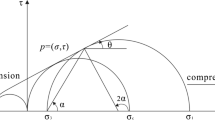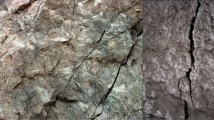Abstract
Reliable prediction of the potential collapse region of rock mass is a key challenge for deep underground cavity excavation, especially if a concealed karst cave is located above the excavated cavity. Because of the effect of the blast vibration, a possible collapse would occur at a certain region between the concealed karst cave and the excavated cavity. This paper aims to study the roof collapse of a deep buried cavity induced by a concealed karst cave base on a two-dimensional failure mechanism by using upper bound theorem. The failure mechanism is constituted by arbitrary curves which is similar to the collapse observed in an actual cavity excavation. The shape and range of the collapse block is determined by virtual work equation in conjunction with variational approach. The results obtained by the presented approach are approximate with the numerical results provided by finite difference code, which indicates that the proposed method in this work is valid.
摘要
可靠地预测由于地下工程施工导致的围岩塌落范围是地下工程施工中遇到的一个关键问题。尤 其当地下硐室上方存在隐伏溶洞时, 由于施工过程中爆破振动的影响, 增大了地下硐室与隐伏溶洞之 间围岩发生垮塌的可能性。针对这一现象, 利用任意线型的曲线构建了由于隐伏溶洞诱发深埋硐室顶 部围岩塌落破坏的二维破坏机制。在此基础上, 基于极限分析上限定理的虚功率方程和变分法计算得 到了深埋硐室顶部围岩塌落面的解析方程, 并绘制了不同参数作用下深埋硐室顶部围岩塌落面的形状 和范围。为了验证理论结果的正确性, 将计算得到的围岩塌落面理论解和数值模拟得到的数值解进行 了对比。分析表明: 理论解和数值解基本一致, 证明本文的理论计算结果是有效的。
Similar content being viewed by others
References
XIAO X X, XU M, DING Q Z, KANG X B, XIA Q, DU F. Experimental study investigating deformation behavior in land overlying a karst cave caused by groundwater level changes [J]. Environmental Earth Sciences, 2018, 77(3): 64–75.
ZHAO Y L, PENG Q Y, WAN W, WANG W J, CHEN B. Fluid-solid coupling analysis of rock pillar stability for concealed karst cave ahead of a roadway based on catastrophic theory [J]. International Journal of Mining Science and Technology, 2014, 24: 737–745.
CUI Q L, SHEN S L, XU Y S, WU H N, YIN Z Y. Mitigation of geohazards during deep excavations in karst regions with caverns: A case study [J]. Engineering Geology, 2015, 195: 16–27.
JIANG H M, LI L, RONG X L, WANG M Y, XIA Y P, ZHANG Z C. Model test to investigate waterproof-resistant slab minimum safety thickness for water inrush geohazards [J]. Tunnelling and Underground Space Technology, 2017, 62: 35–42.
LI S C, WU J, XU Z H, ZHOU L, ZHANG B. A possible prediction method to determine the top concealed karst cave based on displacement monitoring during tunnel construction [J]. Bulletin of Engineering Geology and the Environment, 2017. DOI: https://doi.org/10.1007/s10064-017-1060-1.
FRALDI M, GUARRACINO F. Limit analysis of collapse mechanisms in cavities and tunnels according to the Hoek-Brown failure criterion [J]. International Journal of Rock Mechanics and Mining Sciences, 2009, 46: 665–673.
FRALDI M, GUARRACINO F. Analytical solutions for collapse mechanisms in tunnels with arbitrary cross sections [J]. International Journal of Solids and Structures, 2010, 47: 216–223.
FRALDI M, GUARRACINO F. Limit analysis of progressive tunnel failure of tunnels in Hoek-Brown rock masses [J]. International Journal of Rock Mechanics and Mining Sciences, 2012, 50: 170–173.
HUANG F, ZHAO L H, LING T H, YANG X L. Rock mass collapse mechanism of concealed karst cave beneath deep tunnel [J]. International Journal of Rock Mechanics and Mining Sciences, 2017, 91: 133–138.
CHEN W F. Limit analysis and soil plasticity [M]. Amsterdam: Elsevier, 1975.
HUANG F, OU R C, LI Z L, YANG X L, LING T H. Limit analysis for the face stability of a shallow-shield tunnel based on a variational approach to the blow-out failure mode [J]. International Journal of Geomechanics, 2018, 18(6): 04018038.
PAN Q, DIAS D. Three dimensional face stability of a rock tunnel subjected to seepage forces [J]. Tunnelling and Underground Space Technology, 2018, 71: 555–566.
UKRITCHON B, KEAWSAWASVONG S. Stability of unlined square tunnels in Hoek-Brown rock masses based on lower bound analysis [J]. Computers and Geotechnics, 2019, 105: 249–264.
ZHANG D B, LIU Z Z, ZHANG J H. A new failure mechanism for deep cavity and upper bound solution of supporting pressure [J]. Journal of Central South University, 2017, 24(9): 2082–2091.
YANG X L, ZHANG S. Risk assessment model of tunnel water inrush based on improved attribute mathematical theory [J]. Journal of Central South University, 2018, 25(2): 379–391.
XU J S, YANG X L. Seismic stability of 3D soil slope reinforced by geosynthetic with nonlinear failure criterion [J]. Soil Dynamics and Earthquake Engineering, 2019, 118: 86–97.
LI Y X, YANG X L. Soil-slope stability considering effect of soil-strength nonlinearity [J]. International Journal of Geomechanics, 2019, 19(3): 04018201
LI Z W, YANG X L. Kinematical analysis of active earth pressure considering tension crack, pore-water pressure and soil nonlinearity [J]. KSCE Journal of Civil Engineering, 2019, 23(1): 56–62.
MOLLON G, DIAS D, SOUBRA A H. Continuous velocity fields for collapse and blowout of a pressurized tunnel face in purely cohesive soil [J]. International Journal for Numerical and Analytical Methods in Geomechanics, 2013, 37(13): 2061–2083.
IBRAHIM E, SOUBRA A H, MOLLON G, RAPHAEL W, DIAS D, REDA A. Three-dimensional face stability analysis of pressurized tunnels driven in a multilayered purely frictional medium [J]. Tunnelling and Underground Space Technology, 2015, 49: 18–34.
MOLLON G, PHOON K K, DIAS D, SOUBRA A H. Validation of a new 2D failure mechanism for the stability analysis of a pressurized tunnel face in a spatially varying sand [J]. Journal of Engineering Mechanics, 2011, 137(1): 8–21.
HOEK E, BROWN E T. Practical estimate the rock mass strength [J]. International Journal of Rock Mechanics and Mining Sciences. 1997, 34: 1165–1186.
Author information
Authors and Affiliations
Corresponding author
Additional information
Foundation item
Projects(51878074, 51678071) supported by the National Natural Science Foundation of China
Rights and permissions
About this article
Cite this article
Huang, F., Zhang, M. & Jiang, Z. Collapse mode of rock mass induced by a concealed karst cave above a deep cavity. J. Cent. South Univ. 26, 1747–1754 (2019). https://doi.org/10.1007/s11771-019-4130-7
Received:
Accepted:
Published:
Issue Date:
DOI: https://doi.org/10.1007/s11771-019-4130-7




